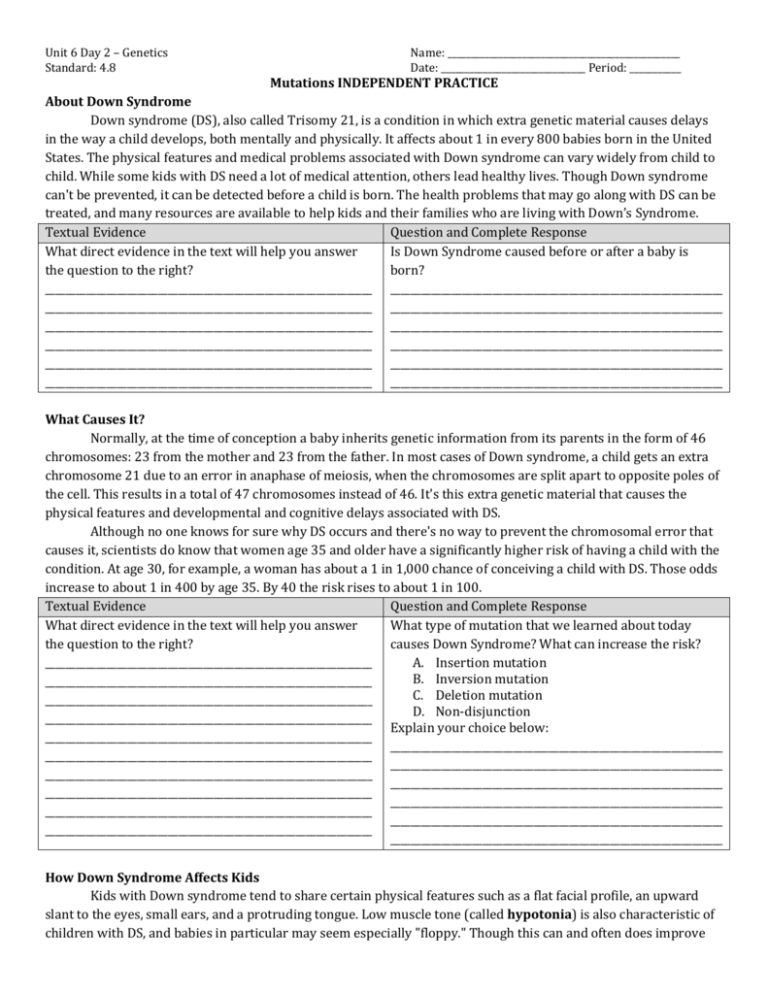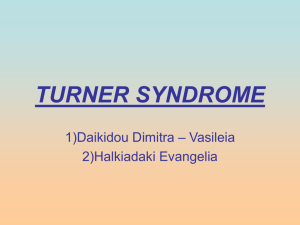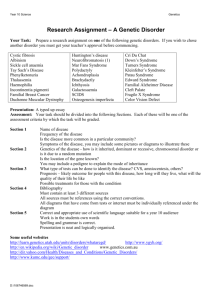File
advertisement

Unit 6 Day 2 – Genetics Standard: 4.8 Name: __________________________________________________ Date: _______________________________ Period: ___________ Mutations INDEPENDENT PRACTICE About Down Syndrome Down syndrome (DS), also called Trisomy 21, is a condition in which extra genetic material causes delays in the way a child develops, both mentally and physically. It affects about 1 in every 800 babies born in the United States. The physical features and medical problems associated with Down syndrome can vary widely from child to child. While some kids with DS need a lot of medical attention, others lead healthy lives. Though Down syndrome can't be prevented, it can be detected before a child is born. The health problems that may go along with DS can be treated, and many resources are available to help kids and their families who are living with Down’s Syndrome. Textual Evidence Question and Complete Response What direct evidence in the text will help you answer Is Down Syndrome caused before or after a baby is the question to the right? born? ________________________________________________________________ _________________________________________________________________ ________________________________________________________________ _________________________________________________________________ ________________________________________________________________ _________________________________________________________________ ________________________________________________________________ _________________________________________________________________ ________________________________________________________________ _________________________________________________________________ ________________________________________________________________ _________________________________________________________________ What Causes It? Normally, at the time of conception a baby inherits genetic information from its parents in the form of 46 chromosomes: 23 from the mother and 23 from the father. In most cases of Down syndrome, a child gets an extra chromosome 21 due to an error in anaphase of meiosis, when the chromosomes are split apart to opposite poles of the cell. This results in a total of 47 chromosomes instead of 46. It's this extra genetic material that causes the physical features and developmental and cognitive delays associated with DS. Although no one knows for sure why DS occurs and there's no way to prevent the chromosomal error that causes it, scientists do know that women age 35 and older have a significantly higher risk of having a child with the condition. At age 30, for example, a woman has about a 1 in 1,000 chance of conceiving a child with DS. Those odds increase to about 1 in 400 by age 35. By 40 the risk rises to about 1 in 100. Textual Evidence Question and Complete Response What direct evidence in the text will help you answer What type of mutation that we learned about today the question to the right? causes Down Syndrome? What can increase the risk? ________________________________________________________________ A. Insertion mutation B. Inversion mutation ________________________________________________________________ C. Deletion mutation ________________________________________________________________ D. Non-disjunction ________________________________________________________________ Explain your choice below: ________________________________________________________________ _________________________________________________________________ ________________________________________________________________ _________________________________________________________________ ________________________________________________________________ _________________________________________________________________ ________________________________________________________________ _________________________________________________________________ ________________________________________________________________ _________________________________________________________________ ________________________________________________________________ _________________________________________________________________ How Down Syndrome Affects Kids Kids with Down syndrome tend to share certain physical features such as a flat facial profile, an upward slant to the eyes, small ears, and a protruding tongue. Low muscle tone (called hypotonia) is also characteristic of children with DS, and babies in particular may seem especially "floppy." Though this can and often does improve over time, most children with DS typically reach developmental milestones — like sitting up, crawling, and walking — later than other kids. At birth, kids with DS are usually of average size, but they tend to grow at a slower rate and remain smaller than their peers. For infants, low muscle tone may contribute to sucking and feeding problems, as well as constipation and other digestive issues. Toddlers and older kids may have delays in speech and self-care skills like feeding, dressing, and toilet teaching. Down syndrome affects kids' ability to learn in different ways, but most have mild to moderate intellectual impairment. Kids with DS can and do learn, and are capable of developing skills throughout their lives. They simply reach goals at a different pace — which is why it's important not to compare a child with DS against typically developing siblings or even other children with the condition. Kids with DS have a wide range of abilities, and there's no way to tell at birth what they will be capable of as they grow up. But they deserve all the respect and care afforded to any person. Textual Evidence Question and Complete Response What direct evidence in the text will help you answer Does having a genetic mutation like the one that causes the question to the right? Down Syndrome mean a person can never lead a normal ________________________________________________________________ life? Why or why not? What are some typical symptoms? ________________________________________________________________ _________________________________________________________________ ________________________________________________________________ _________________________________________________________________ ________________________________________________________________ _________________________________________________________________ ________________________________________________________________ _________________________________________________________________ ________________________________________________________________ _________________________________________________________________ ________________________________________________________________ _________________________________________________________________ ________________________________________________________________ _________________________________________________________________ ________________________________________________________________ _________________________________________________________________ ________________________________________________________________ _________________________________________________________________ ________________________________________________________________ _________________________________________________________________ Which person has Turner Syndrome? Which is a girl? Which is a boy?







